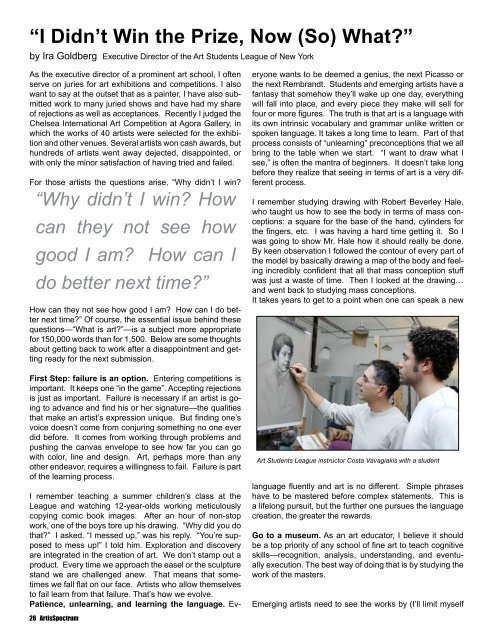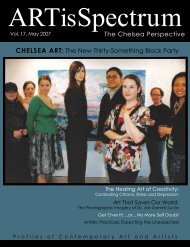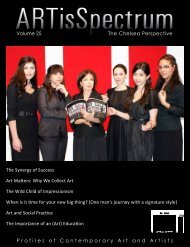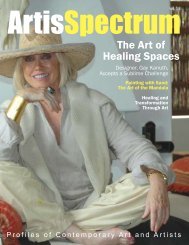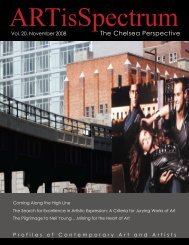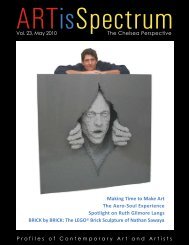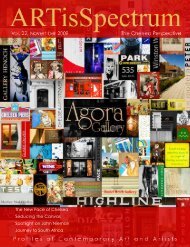Download PDF - ARTisSpectrum
Download PDF - ARTisSpectrum
Download PDF - ARTisSpectrum
Create successful ePaper yourself
Turn your PDF publications into a flip-book with our unique Google optimized e-Paper software.
“I Didn’t Win the Prize, Now (So) What?”<br />
by Ira Goldberg Executive Director of the Art Students League of New York<br />
As the executive director of a prominent art school, I often<br />
serve on juries for art exhibitions and competitions. I also<br />
want to say at the outset that as a painter, I have also submitted<br />
work to many juried shows and have had my share<br />
of rejections as well as acceptances. Recently I judged the<br />
Chelsea International Art Competition at Agora Gallery, in<br />
which the works of 40 artists were selected for the exhibition<br />
and other venues. Several artists won cash awards, but<br />
hundreds of artists went away dejected, disappointed, or<br />
with only the minor satisfaction of having tried and failed.<br />
For those artists the questions arise, “Why didn’t I win?<br />
“Why didn’t I win? How<br />
can they not see how<br />
good I am? How can I<br />
do better next time?”<br />
How can they not see how good I am? How can I do better<br />
next time?” Of course, the essential issue behind these<br />
questions—“What is art?”—is a subject more appropriate<br />
for 150,000 words than for 1,500. Below are some thoughts<br />
about getting back to work after a disappointment and getting<br />
ready for the next submission.<br />
First Step: failure is an option. Entering competitions is<br />
important. It keeps one “in the game”. Accepting rejections<br />
is just as important. Failure is necessary if an artist is going<br />
to advance and find his or her signature—the qualities<br />
that make an artist’s expression unique. But finding one’s<br />
voice doesn’t come from conjuring something no one ever<br />
did before. It comes from working through problems and<br />
pushing the canvas envelope to see how far you can go<br />
with color, line and design. Art, perhaps more than any<br />
other endeavor, requires a willingness to fail. Failure is part<br />
of the learning process.<br />
I remember teaching a summer children’s class at the<br />
League and watching 12-year-olds working meticulously<br />
copying comic book images. After an hour of non-stop<br />
work, one of the boys tore up his drawing. “Why did you do<br />
that?” I asked. “I messed up,” was his reply. “You’re supposed<br />
to mess up!” I told him. Exploration and discovery<br />
are integrated in the creation of art. We don’t stamp out a<br />
product. Every time we approach the easel or the sculpture<br />
stand we are challenged anew. That means that sometimes<br />
we fall flat on our face. Artists who allow themselves<br />
to fail learn from that failure. That’s how we evolve.<br />
Patience, unlearning, and learning the language. Everyone<br />
wants to be deemed a genius, the next Picasso or<br />
the next Rembrandt. Students and emerging artists have a<br />
fantasy that somehow they’ll wake up one day, everything<br />
will fall into place, and every piece they make will sell for<br />
four or more figures. The truth is that art is a language with<br />
its own intrinsic vocabulary and grammar unlike written or<br />
spoken language. It takes a long time to learn. Part of that<br />
process consists of “unlearning” preconceptions that we all<br />
bring to the table when we start. “I want to draw what I<br />
see,” is often the mantra of beginners. It doesn’t take long<br />
before they realize that seeing in terms of art is a very different<br />
process.<br />
I remember studying drawing with Robert Beverley Hale,<br />
who taught us how to see the body in terms of mass conceptions:<br />
a square for the base of the hand, cylinders for<br />
the fingers, etc. I was having a hard time getting it. So I<br />
was going to show Mr. Hale how it should really be done.<br />
By keen observation I followed the contour of every part of<br />
the model by basically drawing a map of the body and feeling<br />
incredibly confident that all that mass conception stuff<br />
was just a waste of time. Then I looked at the drawing…<br />
and went back to studying mass conceptions.<br />
It takes years to get to a point when one can speak a new<br />
Art Students League instructor Costa Vavagiakis with a student<br />
language fluently and art is no different. Simple phrases<br />
have to be mastered before complex statements. This is<br />
a lifelong pursuit, but the further one pursues the language<br />
creation, the greater the rewards.<br />
Go to a museum. As an art educator, I believe it should<br />
be a top priority of any school of fine art to teach cognitive<br />
skills—recognition, analysis, understanding, and eventually<br />
execution. The best way of doing that is by studying the<br />
work of the masters.<br />
Emerging artists need to see the works by (I’ll limit myself<br />
26 ArtisSpectrum


